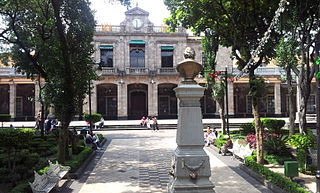
Tlalpan is a borough in Mexico City. It is the largest borough, with over 80% under conservation as forest and other ecologically sensitive area. The rest, almost all of it on the northern edge, has been urban since the mid-20th century. When it was created in 1928, it was named after the most important settlement of the area, Tlalpan, which is referred to as “Tlalpan center” to distinguish it from the borough.
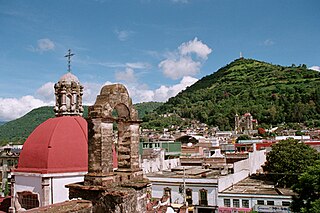
Tenancingo is one of 125 municipalities in the State of Mexico, Mexico. The municipal seat is the town of Tenancingo de Degollado. The municipality is located in the south of the state, in the Tenancingo Valley, just outside the Toluca Valley. The official name of the municipality is only Tenancingo but the town is Tenancingo de Degollado and is often confused with Tenancingo, Tlaxcala, which is a town in a different state.

Tonalá is a city and municipality within the Guadalajara Metropolitan Area in the state of Jalisco in Mexico. With a population of 442,440, it is the fourth largest city in the state, the other three being the other major population centres in the metro area: Guadalajara, Zapopan, and Tlaquepaque. It is best known as a major handcrafts center for Jalisco, especially pottery, as well as its very large Thursday and Sunday street market, dedicated to handcrafts.

Luis Nishizawa Flores was a Mexican artist known for his landscape work and murals, which often show Japanese and Mexican influence. He began formal training as an artist in 1942 at the height of the Mexican muralism movement but studied other painting styles as well as Japanese art.

A tianguis is an open-air market or bazaar that is traditionally held on certain market days in a town or city neighborhood in Mexico and Central America. This bazaar tradition has its roots well into the pre-Hispanic period and continues in many cases essentially unchanged into the present day. The word tianguis comes from tiyānquiztli or tianquiztli in Classical Nahuatl, the language of the Aztec Empire. In rural areas, many traditional types of merchandise are still sold, such as agriculture supplies and products as well as modern, mass-produced goods. In the cities, mass-produced goods are mostly sold, but the organization of tianguis events is mostly the same. There are also specialty tianguis events for holidays such as Christmas as well as for particular types of items such as cars or art.

Zinacantepec is a municipality located just west of the city of Toluca in Mexico State, Mexico. The municipal seat is the town of San Miguel Zinacantepec. Zinacantepec is Nahuatl for "bat mountain" and its Aztec glyph is a bat on a mountain. It is named after a small mountain which contained two caves which used to be filled with thousands of bats.

Leopoldo Flores was a Mexican artist mostly known for his murals and other monumental works which are concentrated in the city of Toluca, State of Mexico. He was born into a poor family in rural State of Mexico, but his artistic ability was evident early and he was able to attend the Escuela Nacional de Pintura, Escultura y Grabado "La Esmeralda" and receive a scholarship to study in Paris. His best known works are the Cosmovitral a large work in stained glass and the Aratmósfera, a “land art” piece both located in Toluca. The first is used as a symbol for the State of Mexico and the latter dominates the main stadium and the hill behind it at the main campus of the Universidad Autónoma del Estado de México (UAEM). He received a number of recognitions of his work from the State of Mexico and an honorary doctorate from the UAEM, which also founded the Museo Universitario Leopoldo Flores to house and promote his work. Despite advanced Parkinson's disease, until his death Flores was still an active artist.
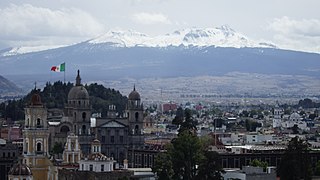
Toluca, officially Toluca de Lerdo, is the state capital of the State of Mexico as well as the seat of the Municipality of Toluca. Toluca has a population of 910,608 as of the 2020 census. The city forms the core of the Greater Toluca metropolitan area, which with a combined population of 2,347,692 forms the fifth most populous metropolitan area in the country. Located 63 kilometres (39 mi) southwest of Mexico City, the city's rapid growth stems largely from its proximity to the capital.
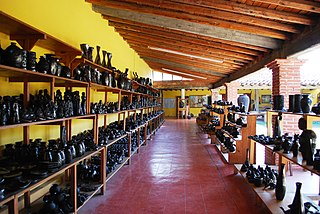
San Bartolo Coyotepec is a town and municipality located in the center of the Mexican state of Oaxaca. It is in the Centro District of the Valles Centrales region about fifteen km south of the capital of Oaxaca.

The Museo de Arte Popular is a museum in Mexico City, Mexico, that promotes and preserves part of the Mexican handcrafts and folk art. Located in the historic center of Mexico City in an old fire house, the museum has a collection which includes textiles, pottery, glass, piñatas, alebrijes, furniture and much more. However, the museum is best known as the sponsor of the yearly Noche de Alebrijes parade in which the fantastical creatures are constructed on a monumental scale and then paraded from the main plaza or Zocalo to the Angel of Independence monument, competing for prizes.

The Museo Estatal de Arte Popular de Oaxaca or MEAPO is a small museum in the municipality of San Bartolo Coyotepec just south of the city of Oaxaca in Mexico. It is run by the state of Oaxaca to showcase the entity's handcrafts and folk art tradition, through its permanent collection, online "cyber-museum", collaboration with national and international entities, and sponsorship of events such as craft markets, conferences, and temporary exhibitions. It is dedicated to the crafts and to the artisans and the cultures behind the items. Its collection contains samples of most of the crafts produced in the state, especially the Central Valleys region, but most of its collection consists of barro negro pottery, the specialty of San Bartolo Coyotepec. It is run by director Carlomagno Pedro Martínez, a recognized artisan and artist in barro negro.

Museo Universitario de Artes Populares María Teresa Pomar is a museum dedicated to Mexico's handcrafts and folk art tradition, called “artesanía.” It is part of the University of Colima in the city of Colima, founded by artesanía collector and promoter María Teresa Pomar. It contains one of the most important collections of its type in Mexico, covering traditions from around the country as well as the artesanía and traditions of the state of Colima.

Museo Nacional de las Culturas Populares is a museum in Mexico City dedicated to Mexico's ethnic and cultural diversity. This diversity not only includes that of its indigenous peoples, but also those of its regions and socioeconomic strata. It was founded in 1982 by anthropologist Guillermo Bonfil Batalla at a time when the country was accepting and promoting its cultural diversity. The museum does not have a large permanent collection but rather focuses on temporary exhibits, concerts, workshops and other cultural and educational events as well as promoting the creation of museums in Mexico to promote local cultures. The museum is also home to the Centro de Información y Documentación Alberto Beltrán, founded in 1971 to promote research and knowledge about Mexican handcrafts and folk art and indigenous ethnicities.

Heriberto Juárez was a self-taught Mexican sculptor, known for his depictions of women and animals, especially bulls. As a youth he wanted to be a bullfighter but gave this up when he found he could sell figures he made. While never formally trained, he had over seventy individual exhibitions of his work in Mexico and the United States and his work can be found in prominent public and private collections.
Celso Camacho Quiroz is a fourth-generation Mexican potter who works in Metepec, in the State of Mexico. His specialty is the making of large cooking vessels called “cazuelas,” traditionally used to cook mole and rice, but he also makes a number of other utilitarian and decorative pieces. His work has been recognized with awards such as the Gran Premio de Arte Popular from FONART in 1999 and being named a “grand master” by the Fomento Cultural Banamex in 2003.
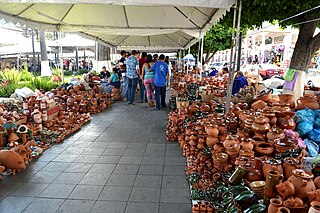
The Palm Sunday Handcraft Market held in Uruapan, is the largest event in the Mexican state of Michoacán dedicated to the sale of the state’s traditional handcrafts and is reputed to be the largest of its kind in Latin America. The event draws over 1,300 artisans who offer over a million pieces for sale, which represent all of the state’s major handcraft traditions. It also includes other events such as a handcraft competition, exhibition of indigenous dress, food and other traditions, concerts, dance and more. The event is centered on the very large main plaza of the city of Uruapan, but extends over to adjoining streets and to other plazas in the city.

Handcrafts and folk art in Mexico City is a microcosm of handcraft production in most of the rest of country. One reason for this is that the city has attracted migration from other parts of Mexico, bringing these crafts. The most important handcraft in the city is the working of a hard paper mache called cartonería, used to make piñatas and other items related to various annual celebrations. It is also used to make fantastic creatures called alebrijes, which originated here in the 20th century. While there are handcrafts made in the city, the capital is better known for selling and promoting crafts from other parts of the country, both fine, very traditional wares and inexpensive curio types, in outlets from fine shops to street markets.

The Mexican State of Mexico produces various kinds of handcrafted items. While not as well documented as the work of other states, it does produce a number of notable items from the pottery of Metepec, the silverwork of the Mazahua people and various textiles including handwoven serapes and rebozos and knotted rugs. There are seventeen recognized handcraft traditions in the state, and include both those with pre Hispanic origins to those brought over by the Spanish after the Conquest. As the state industrializes and competition from cheaper goods increases, handcraft production has diminished. However, there are a number of efforts by state agencies to promote these traditions both inside and outside of Mexico.

Marta Turok is a Mexican applied anthropologist focusing on socio-economic development, and one of the foremost schools on Mexican folk art. Through research, government work, education and advocacy, she has worked to raise the prestige of Mexican handcrafts and folk art and to help artisans improve their economic status. Her work has been recognized with awards from various governmental and non-governmental agencies.





















